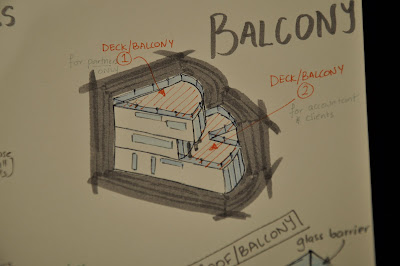This is the conference room area (the furniture has been discussed in the previous post). As visible in this snapshot, there are 2 red doors leading to male and female bathrooms at the end of the building. One more aspect that is shown beautifully in this snapshot is the strip of glass above the wooden siding beneath the concrete ceiling - this aspect is a vehicle to transport sunlight into the building, which is essential for a working environment and also enhancing its warmth.
This shot shows the entrance of the building from the exterior. This door (and all the other doors) are scripted so that when they are touched, they will slide upwards to allow us to enter the building, and later slide back down after 5 seconds. This snapshot once again shows the layer of glass above the siding that functions similarly to a skylight.
Once again, I decided to make my own texture for the doors in photoshop. I wanted a simple texture with a strong colour that constrasts the wood, concrete and glass of the building. I decided on 2 soft red shades very similar to each other and simply made a gradient - being a very warm, soft and inviting as well as intimate texture.
I also applied the red texture to the elevator I had constructed in the middle of part 2 of the building (workspace) that transports partners to the roof. Another feature visible in this snapshot are the tables in the working space. I wanted a raw, rather than box type look for them, therefore slightly tapered and distorted the original cuboid shapes to make irregular shapes out of glass (with smooth edges of course). Each table is supported by a wooden collumn that contrasts with the modernity of the glass. These tables are situated so that the partners will be able to look out of the windows whenever they are working, and have direct sunlight whenever possible.
This snapshot shows my sculptie which I had decided to keep in my building. I traded a scultie with archit and april but their ones didnt suit the theme of my building, therefore I decided to use my own sculptie. I have made a script for the sculptie which says "Sursum" (Reach for the heights) forever. This is to motivate the partners and clients to strive for as much perfection as they can in their work, The sharp corners pointing upwards also reinforves this message of striving for the highest form of success.


















































